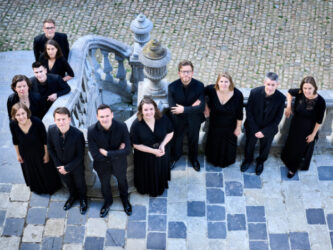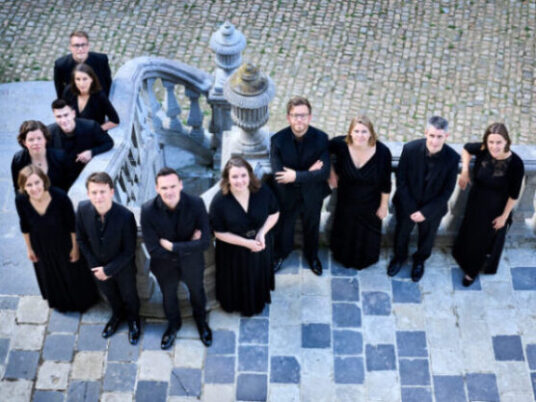 United States Various, ‘England’s Nightingale: The Remarkable Music of William Byrd’: Stile Antico, Church of St. Mary the Virgin, New York, 29.4.2023. (RP)
United States Various, ‘England’s Nightingale: The Remarkable Music of William Byrd’: Stile Antico, Church of St. Mary the Virgin, New York, 29.4.2023. (RP)

Byrd – ‘Emendemus in Melius’, ‘Sing joyfully’, ‘Nunc Dimittis’ (from The Great Service), ‘Vide Domine afflictionem nostram’, ‘Haec dies’, ‘Ne irascaris, ‘Retire my soul’, ‘Laudate Dominum’, ‘Agnus Dei’ (from Mass for Four Voices), ‘Laudibus in sanctis’
Thomas Morley – ‘Domine Dominus noster’
Peter Philips – ‘Ecce vicit Leo’
Thomas Tomkins – ‘Too much I once lamented’
Stile Antico commemorated the 400th anniversary of the death of William Byrd at New York’s Church of St. Mary the Virgin with music by the composer and three of his students, Thomas Morley, Peter Philips and Thomas Tomkins. It was the concluding concert in Miller Theatre at Columbia University School of the Arts’s 2022/23 Early Music series.
The twelve-member vocal ensemble from London counts Byrd among its favorite composers, and the program revealed not only Byrd’s remarkable creativity but also Stile Antico’s superb artistry. The title of the program was taken from words by Robert Dow penned in praise of Byrd during his lifetime: ‘You who are the glory to our race, and a nightingale to our people’. With the death of Thomas Tallis in 1585, Dow’s words acknowledged that after Tallis’s death, Byrd was the preeminent English composer of the day.
Byrd walked a religious tightrope that ran across Tudor England, from which many slipped and fell to their deaths. He was a Gentleman of the Chapel Royal during the reigns of Henry VIII, Edward VI, Mary I and Elizabeth I, when England lurched between Protestantism and Catholicism. In spite of his Catholic leanings, he nonetheless flourished. Queen Elizabeth I, a great music lover and patron of the arts, was undoubtedly his protector.
The program opened with Byrd’s ‘Emendemus in Melius’, a setting of a verse from Psalm 78 used as Matins Responsory for the first Sunday of Lent. It was, however, not intended for use in the Anglican church, but rather to be sung by skilled amateur musicians for their own personal enjoyment. In this solemn homophonic work, Stile Antico displayed the qualities that marked every work they sang – exquisite blend, impeccable tuning, superb diction and brilliant musicianship.
They followed with two examples of Byrd as a loyal subject of Elizabeth, ’Sing Joyfully’ and ‘Nunc Dimittis’ from The Great Service. Rediscovered in the early twentieth century, the work for double five-part choirs is one of the glories of English church music. The warmth of the ensemble’s sound, especially in its homophonic sections, was underpinned by the richness and resonance of the bass voices which are but one of the many glories of Stile Antico.
Two settings of the Lamentations were prime examples of Byrd’s Catholic sensibilities. Catholics in Tudor England compared their plight to that of the destruction of Jerusalem which the texts describe. The two extensive choral settings were prime examples of Stile Antico’s ability to express emotion through sound and to paint text through voice alone.
In ‘Vide Domine afflictionem nostram’, they sang of ‘Pax sanctissima’ in tones that were soft, luminous and transparent. An overwhelming sense of desolation and desperation prevailed as the singers gave voice to images of Jerusalem as a desert. Their singing of the fugal setting of the penultimate line of the text was perfectly balanced, with each entrance adding to the tension. The final bleak, homophonic setting of the words ‘Jerusalem desolata est’ was the most emotionally penetrating moment of the concert.
In 1593, Byrd left London for Stondon Massey in Essex to live near his Catholic patron, Sir John Petre. It was there that he wrote his Gradualia, a complete cycle of music for the Catholic feasts. Byrd’s compositional style in the Gradualia exhibits a confidence and joyfulness that was less evident in the music he composed during his London years. ‘Laudate Dominum’, a motet in the collection, was given a loud, triumphant performance by Stile Antico.
Morley’s joyful ‘Domine, Dominus noster’, composed when he was only 19 years old, was given a buoyant performance. A Catholic, Philips left England in 1582 for Flanders, never to return. His ‘Ecce vicit Leo’, set for two four-voice choirs, was jubilant and notable for the clarity and precision of the antiphonal singing. Tomkins’s madrigal, ‘Too much I once lamented’, which he dedicated to Byrd. was sung with drollness and wit. The tuning of the work’s dissonances was particularly exquisite.
Blaring sirens outside the church, which is located just a block from Times Square, delayed the start of the final work on the program for a few moments. Undaunted, Stile Antico ended this fine concert of music by English masters with a glorious performance of Byrd’s ‘Laudibus in sanctis’. It was introduced as a riotous celebration of God and music, and indeed it was.
Rick Perdian
